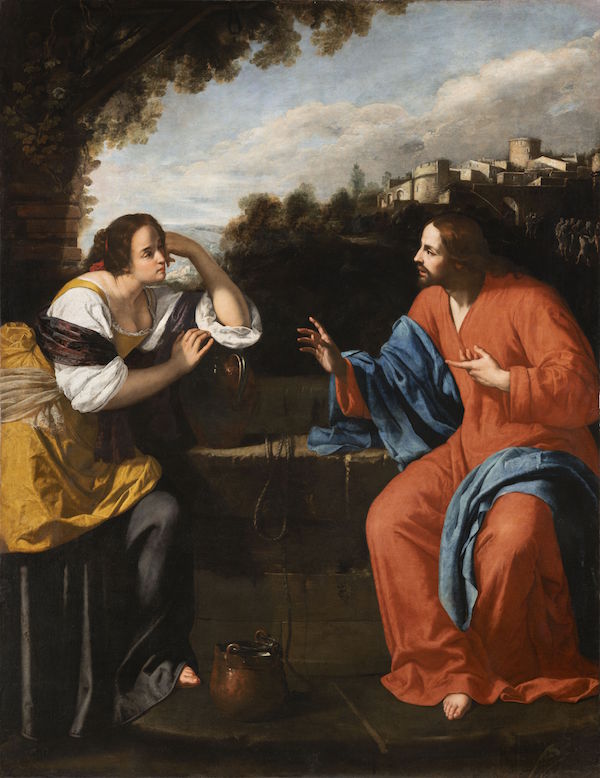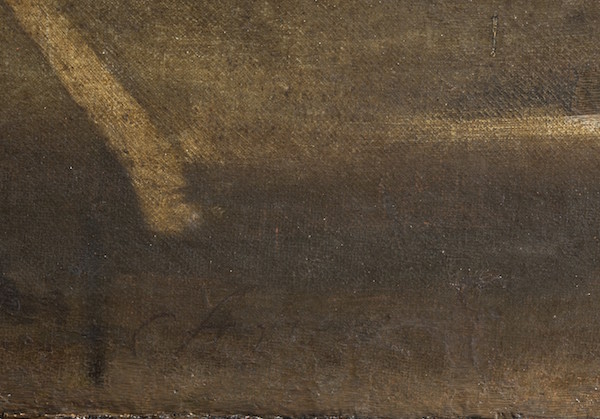Artemisia Gentileschi (1636 – 1637), Christ and the Samaritan woman at the well, (detail of the Samaritan woman), 1636-37. Oil on canvas I Courtesy Palazzo Blu
Christ and the Samaritan woman it is the work of an artistically mature Artemisia, created in Naples between 1636 and 1637. The painter faithfully reproduces the story of the Gospel of John, reinterpreting with excited participation the realism imposed in painting by Caravaggio a few years earlier. In the background are the disciples returning from the city where they had gone to buy supplies, while the figures of Jesus and the Samaritan woman emerge in the foreground. Although immersed in a supernatural aura, Christ has a sweet expression as he pronounces words that sound like an enigma: “Whoever drinks this water will be thirsty again – he says – but whoever drinks the water that I will give him will not will be thirsty forever. Indeed, the water that I will give him will become in him a spring of water welling up to eternal life”. Surprised, confused, fascinated like the Samaritan woman in the painting, the artist invites the viewer to understand and adopt the master’s message.

Artemisia Gentileschi (1636 – 1637), Christ and the Samaritan woman at the well, 1636-37. Oil on canvas I Courtesy Palazzo Blu
“A little less than two years ago, a friend told us of the presence in a Sicilian noble family of a large canvas by Artemisia which represents the encounter between Christ and the Samaritan woman at Jacob’s well” says the president of the Palazzo Blue Cosimo Bracci Torsi: “The work of a sacred subject, by an Artemisia different from the somewhat truculent proto-feminist with the Judiths, the Lucretias and the Cleopatra which has recently come into fashion, immediately appeared to be of great interest and extraordinary quality”.
Identified in 2004 by Luciano Arcangeli and exhibited to the public for the first time in 2012 in Milan in the great exhibition dedicated to the artist at Palazzo Reale, the Palazzo Blu canvas can boast “an extraordinary collector’s pedigree”, as the historian of the Artemisia art and expert Francesco Solinas of the Collège de France in Paris. It was Gentileschi herself who described the painting in detail, including dimensions, in two letters dated autumn 1637 addressed to Cavalier Cassiano dal Pozzo, his illustrious admirer and protector at the court of Rome. Through the Knight, the artist offered the Samaritan woman to the cardinal brothers Francesco and Antonio Barberini, nephews of the reigning Pope Urban VIII. The Barberinis never bought the painting, which was probably sold only after the artist’s return from London, in the spring of 1641. After passing through the Neapolitan and Sicilian collections of the noble Ruffos, the painting reached Palermo before 1680, entering the prestigious collection of the Duke of Sperlinga and his heirs, where it remained until the 20th century.
Today it enriches the rich nucleus of works by the Gentileschis conserved in Palazzo Blu, which already includes several paintings by the brothers Aurelio and Baccio, mainly active in Pisa, the Madonna and Child with Saints from Horace and the Muse Clio of Artemisia, acquired in 2004 in an auction in the London branch of Christie’s, as well as the Portrait of Artemisia by Simon Vouet.

Signature of the work ‘A’ by Artemisia Gentileschi, revealed by the restoration carried out in Pisa I Courtesy Palazzo Blu
Research conducted on Christ and the Samaritan woman at the well – reveals the restorer and expert of Artemisia Cinzia Pasquali, consultant for the intervention on the painting – have brought to light “details of great interest: the nature of some substances and pigments, the pentimenti and compositional shifts (both in the preparatory and pictorial phases), the nature of the layers used as a base chromatic, old restorations as well as other particular signs invisible to the naked eye”. Before carrying out the painting, Artemisia prepared the canvas with natural glue on which a colored sizing was applied. Like other painters of her time, in fact, Gentileschi often used brown backgrounds before painting, a fact evident in theAllegory of Painting conserved in London at the Royal Collection. It is also possible to hypothesize that the artist used a preparatory drawing in plaster, a material clearly visible against the dark background.
Thanks to infrared reflectography, we know that Artemisia modified the positions of Christ’s left hand and the Samaritan woman’s left arm during the work. Even the woman’s face underwent several changes: “from the position of the eyes, which suggested a less angled head, to the shape of the hair which fell more in front of her face, just as some folds of Christ’s cloak appear eliminated or simplified in the final version ”, says the restorer. We owe the discovery of another unexpected detail to reflectographic analyses: “an inverted U-shaped laceration located on the upper edge of the well between Christ and the Samaritan woman – continues Pasquali – which appears to have been stitched ab antiquo with a thread of the same cloth”. In all likelihood it would not be a restoration, but a repair made by Artemisia herself on a tear that accidentally occurred in the workshop. The pictorial material that covers the laceration is in fact identical to that of the rest of the work. Finally, a precious gift arrived from the cleaning of the painting which, free from the waste of time and subsequent repaintings, revealed Gentileschi’s signature and definitively confirmed the attribution.

